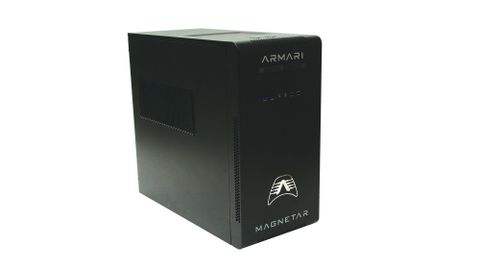IT Pro Verdict
Pros
- +
Blazing CPU performance
- +
Lightning-fast storage
- +
Surprisingly good value
Cons
- -
Consumer GPU not ideal for professional CAD
The benefits of AMD’s 7nm process technology keep coming thick and fast. It’s now filtering through to the Threadripper CPU line, which is entering its third generation. With each new iteration, the maximum Threadripper core count doubles, with 64-core and 48-core variants planned for release later this year. For now, however, the top model is still 32-core. It’s called the AMD Ryzen Threadripper 3970X, and our first look comes in the shape of the Armari Magnetar S64T-RW1300G3 workstation.
The 3970X is essentially the successor to the 2990WX, and it’s a big leap forward. Thanks to the modular design of AMD’s Zen 2 architecture, which allies 7nm 8-core “chiplets” with a 14nm I/O die in one package, the base clock speed has leapt from 3GHz to 3.7GHz, and Turbo from 4.2GHz to 4.5GHz. Thanks to Precision Boost Overdrive (PBO), you don’t get set frequency steps like you do with Intel processors. Instead, the system will provide all-core frequencies up to what your power delivery and cooling can handle. Armari’s use of Enermax Liqtech 280 water cooling means the processor will run comfortably at 4.15GHz across all cores under full load, and 4.5GHz with only a couple of cores. So, unlike most high-core workstations, the S64T-RW1300G3 can offer leading single-threaded grunt alongside phenomenal multithreaded performance.
The new Threadripper natively supports 3,200MHz DDR4 memory in a quad-channel configuration, which is ahead of the 2,933MHz memory supported by most top-end Intel processors. However, Armari populated the ASRock TRX40 Creator motherboard’s eight DIMM slots with four 32GB 2,933MHz modules due to the non-availability of certified 3,200MHz ones at the time of review, for a very healthy total of 128GB. The shipping system will use 3,200MHz memory.
Armari sells a lot of machines to games developers and animators who request consumer-grade graphics, meaning this system comes with a Zotac Blower Nvidia GeForce GTX 2080 Ti accelerator, rather than a Quadro. This is still a beast of a card, with 4,352 CUDA cores running at a base 1,350MHz with a 1,545MHz boost, and 11GB of GDDR6 memory running at an effective 14,000MHz on a 352-bit bus. This provides a huge 616GB/sec of bandwidth. The 2080 Ti has the potential to annihilate any 3D task that isn’t specifically coded for professional graphics drivers. But it’s only PCI Express Gen 3, and the Threadripper 3 motherboard will support Gen 4 cards such as AMD’s Radeon RX 5700 and Radeon Pro W5700 series.
You also get PCI Express 4 support for NVMe storage, and here Armari takes full advantage by supplying a pair of 1TB Corsair Force MP600 M.2 SSD drives. The primary SSD managed 4,984MB/sec reading and 4,285MB/sec writing when tested with CrystalDiskMark 6, which is phenomenal. The fastest PCI Express 3 SSDs we’ve seen only offer two-thirds of the reading throughput, meaning you will enjoy faster boot times and software loading. If you need more storage, there are four 3.5in and two 2.5in cold-swap bays available.

How fast is that 32-core CPU? Well, we can confidently say that this is the fastest workstation we’ve ever tested by a country mile. The overall score in our benchmarks of 682 is 56% better than the fastest 32-core Threadripper 2 workstation we’ve reviewed, and thanks to the high single-core clock speed, there are no weak areas with single-threaded tasks. The image-editing score was 226, with 658 in video encoding and an unbelievable 849 in multitasking.
This system is top of the pack for every type of media activity, and the story continues with 3D rendering. The Maxon Cinebench R15 rendering score was 7,837, 37% faster than the previous 32-core Threadripper, and Cinebench R20 returned a whopping 18,316. We also tried the Blender Gooseberry 3D render test, which it completed in just 348 seconds – almost twice as fast as the previous Threadripper model.
If this system has one Achilles’ heel, it’s that the consumer-grade graphics aren’t so impressive for CAD and product design. In SPECviewperf 13, the system returned 175 in catia-05, 104 in sw-04 and a miserable 20.3 in snx-04. If you’re running Siemens NX, specify a professional graphics card instead with this system. But creo-02 was a very decent 270, and the GeForce 2080 Ti is great for 3D animation and games design: with a 3dsmax-06 score of 256 and maya-05 returning 376, this workstation will blitz 3ds Max or Maya.
However, that’s just a matter of graphics card choice for your given workstation application, and it doesn’t change the underlying fact that this system’s CPU will be brilliant for either modelling or rendering, and this ability is already finding favour with professionals. For instance, Blur Studio used early Threadripper 3 samples to create the VFX for the recently released film Terminator: Dark Fate precisely because it’s so good for modelling, yet doesn’t require a server farm to output renders – you can do this on the workstation itself just as quickly. The Magnetar S64T-RW1300G3 isn’t cheap, but when you consider its firepower, it doesn’t seem that expensive, either.
Armari Magnetar S64T-RW1300G3 specifications
| Processor | 3.7GHz AMD Ryzen Threadripper 3970X CPU |
| RAM | 128GB 3,200MHz DDR4 SDRAM |
| GPU | Zotac Nvidia GeForce RTX 2080 Ti graphics with 11GB GDDR6 memory |
| SSD | 2 x 1TB Corsair MP600 M.2 NVMe SSDs |
| Operating system | Windows 10 Pro 64-bit |
| Warranty (parts & labour unless stated) | 3yr warranty (1yr on-site, 2yr RTB parts and labour) |
Dr James Morris has worked as a technology journalist for over 25 years, including spending nine years on the staff of market-leading computer magazine PC Pro, the last five of which were as the publication’s editor. He specialises in enterprise-grade software and hardware, with a particular focus on content creation. He launched a pioneering video channel for HEXUS.net in 2006 and ran the video reviews channel for TrustedReviews.com for four years. He also runs a successful online digital content and commercial video production company, t-zero communications Ltd.
Dr Morris is a prolific technology writer and contributes commercial content for major IT brands including AMD, BlackBerry, Dell, Cognizant, HP, and IBM. He published a book on artificial intelligence, Can Computers Create Art? in 2009. He is also an academic, and is currently Pathway Director of the MA, Interactive Journalism at City, University of London.
Previously, he was course leader for the BA in Web Media Production at Ravensbourne University. He has a PhD in Philosophy, Art and Social Thought from the European Graduate School in Switzerland, a Master's in Media Arts from the New School in New York, USA, and a Bachelor's in Social Anthropology from the London School of Economics.
Dr. Morris can be found on Twitter at @Cyberwest, or emailed at j@tzero.co.uk



